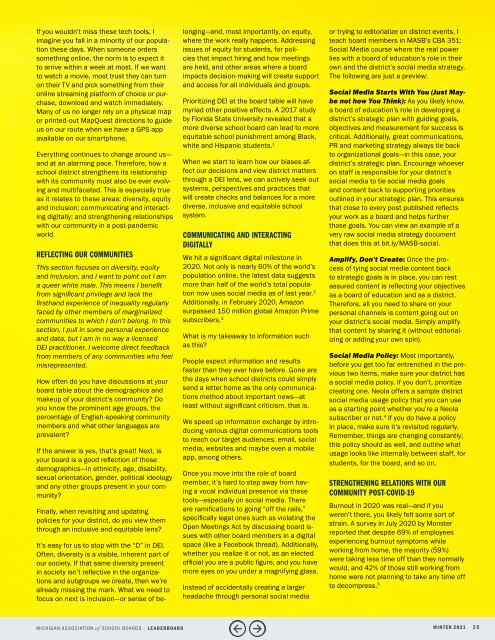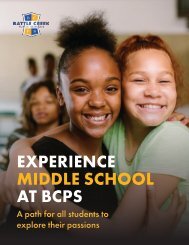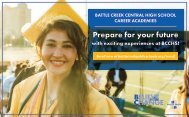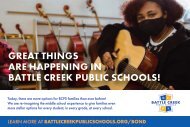MASB Leaderboard Winter 2021 Edition
The Battle Creek Public Schools Board of Education is featured on page 11!
The Battle Creek Public Schools Board of Education is featured on page 11!
- No tags were found...
Create successful ePaper yourself
Turn your PDF publications into a flip-book with our unique Google optimized e-Paper software.
If you wouldn’t miss these tech tools, I<br />
imagine you fall in a minority of our population<br />
these days. When someone orders<br />
something online, the norm is to expect it<br />
to arrive within a week at most. If we want<br />
to watch a movie, most trust they can turn<br />
on their TV and pick something from their<br />
online streaming platform of choice or purchase,<br />
download and watch immediately.<br />
Many of us no longer rely on a physical map<br />
or printed-out MapQuest directions to guide<br />
us on our route when we have a GPS app<br />
available on our smartphone.<br />
Everything continues to change around us—<br />
and at an alarming pace. Therefore, how a<br />
school district strengthens its relationship<br />
with its community must also be ever evolving<br />
and multifaceted. This is especially true<br />
as it relates to these areas: diversity, equity<br />
and inclusion; communicating and interacting<br />
digitally; and strengthening relationships<br />
with our community in a post-pandemic<br />
world.<br />
REFLECTING OUR COMMUNITIES<br />
This section focuses on diversity, equity<br />
and inclusion, and I want to point out I am<br />
a queer white male. This means I benefit<br />
from significant privilege and lack the<br />
firsthand experience of inequality regularly<br />
faced by other members of marginalized<br />
communities to which I don’t belong. In this<br />
section, I pull in some personal experience<br />
and data, but I am in no way a licensed<br />
DEI practitioner. I welcome direct feedback<br />
from members of any communities who feel<br />
misrepresented.<br />
How often do you have discussions at your<br />
board table about the demographics and<br />
makeup of your district’s community? Do<br />
you know the prominent age groups, the<br />
percentage of English-speaking community<br />
members and what other languages are<br />
prevalent?<br />
If the answer is yes, that’s great! Next, is<br />
your board is a good reflection of those<br />
demographics—in ethnicity, age, disability,<br />
sexual orientation, gender, political ideology<br />
and any other groups present in your community?<br />
Finally, when revisiting and updating<br />
policies for your district, do you view them<br />
through an inclusive and equitable lens?<br />
It’s easy for us to stop with the “D” in DEI.<br />
Often, diversity is a visible, inherent part of<br />
our society. If that same diversity present<br />
in society isn’t reflective in the organizations<br />
and subgroups we create, then we’re<br />
already missing the mark. What we need to<br />
focus on next is inclusion—or sense of belonging—and,<br />
most importantly, on equity,<br />
where the work really happens. Addressing<br />
issues of equity for students, for policies<br />
that impact hiring and how meetings<br />
are held, and other areas where a board<br />
impacts decision-making will create support<br />
and access for all individuals and groups.<br />
Prioritizing DEI at the board table will have<br />
myriad other positive effects. A 2017 study<br />
by Florida State University revealed that a<br />
more diverse school board can lead to more<br />
equitable school punishment among Black,<br />
white and Hispanic students. 1<br />
When we start to learn how our biases affect<br />
our decisions and view district matters<br />
through a DEI lens, we can actively seek out<br />
systems, perspectives and practices that<br />
will create checks and balances for a more<br />
diverse, inclusive and equitable school<br />
system.<br />
COMMUNICATING AND INTERACTING<br />
DIGITALLY<br />
We hit a significant digital milestone in<br />
2020. Not only is nearly 60% of the world’s<br />
population online, the latest data suggests<br />
more than half of the world’s total population<br />
now uses social media as of last year. 2<br />
Additionally, in February 2020, Amazon<br />
surpassed 150 million global Amazon Prime<br />
subscribers. 3<br />
What is my takeaway to information such<br />
as this?<br />
People expect information and results<br />
faster than they ever have before. Gone are<br />
the days when school districts could simply<br />
send a letter home as the only communications<br />
method about important news—at<br />
least without significant criticism, that is.<br />
We speed up information exchange by introducing<br />
various digital communications tools<br />
to reach our target audiences: email, social<br />
media, websites and maybe even a mobile<br />
app, among others.<br />
Once you move into the role of board<br />
member, it’s hard to step away from having<br />
a vocal individual presence via these<br />
tools—especially on social media. There<br />
are ramifications to going “off the rails,”<br />
specifically legal ones such as violating the<br />
Open Meetings Act by discussing board issues<br />
with other board members in a digital<br />
space (like a Facebook thread). Additionally,<br />
whether you realize it or not, as an elected<br />
official you are a public figure, and you have<br />
more eyes on you under a magnifying glass.<br />
Instead of accidentally creating a larger<br />
headache through personal social media<br />
or trying to editorialize on district events, I<br />
teach board members in <strong>MASB</strong>’s CBA 351:<br />
Social Media course where the real power<br />
lies with a board of education’s role in their<br />
own and the district’s social media strategy.<br />
The following are just a preview:<br />
Social Media Starts With You (Just Maybe<br />
not how You Think): As you likely know,<br />
a board of education’s role in developing a<br />
district’s strategic plan with guiding goals,<br />
objectives and measurement for success is<br />
critical. Additionally, great communications,<br />
PR and marketing strategy always tie back<br />
to organizational goals—in this case, your<br />
district’s strategic plan. Encourage whoever<br />
on staff is responsible for your district’s<br />
social media to tie social media goals<br />
and content back to supporting priorities<br />
outlined in your strategic plan. This ensures<br />
that close to every post published reflects<br />
your work as a board and helps further<br />
those goals. You can view an example of a<br />
very raw social media strategy document<br />
that does this at bit.ly/<strong>MASB</strong>-social.<br />
Amplify, Don’t Create: Once the process<br />
of tying social media content back<br />
to strategic goals is in place, you can rest<br />
assured content is reflecting your objectives<br />
as a board of education and as a district.<br />
Therefore, all you need to share on your<br />
personal channels is content going out on<br />
your district’s social media. Simply amplify<br />
that content by sharing it (without editorializing<br />
or adding your own spin).<br />
Social Media Policy: Most importantly,<br />
before you get too far entrenched in the previous<br />
two items, make sure your district has<br />
a social media policy. If you don’t, prioritize<br />
creating one. Neola offers a sample district<br />
social media usage policy that you can use<br />
as a starting point whether you’re a Neola<br />
subscriber or not. 4 If you do have a policy<br />
in place, make sure it’s revisited regularly.<br />
Remember, things are changing constantly;<br />
this policy should as well, and outline what<br />
usage looks like internally between staff, for<br />
students, for the board, and so on.<br />
STRENGTHENING RELATIONS WITH OUR<br />
COMMUNITY POST-COVID-19<br />
Burnout in 2020 was real—and if you<br />
weren’t there, you likely felt some sort of<br />
strain. A survey in July 2020 by Monster<br />
reported that despite 69% of employees<br />
experiencing burnout symptoms while<br />
working from home, the majority (59%)<br />
were taking less time off than they normally<br />
would, and 42% of those still working from<br />
home were not planning to take any time off<br />
to decompress. 5<br />
MICHIGAN ASSOCIATION of SCHOOL BOARDS | LEADERBOARD WINTER <strong>2021</strong><br />
25

















